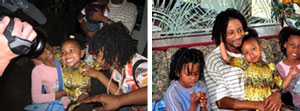Where are the children? (FCN, 10-27-2005)

The destruction of property and loss of life were bad enough after hurricanes Katrina and Rita introduced themselves to the Gulf Coast last August. To add insult to massive injury, their aftermath left 5,192 children missing or displaced.
Months went by and children like Joriel Boykins, a sweet-faced 9-year-old with almond eyes, caramel-colored complexion, pierced ears with braids and ribbons, remained missing. She was last seen with her mother in New Orleans prior to Hurricane Katrina.
No one knew where 6-year-old twins Randy and Ramon McGrew were either. They looked to be fraternal, with Ramon having a darker complexion than Randy. Both have inquisitive eyes.
After the heroic efforts of the National Center for Missing and Exploited Children (NCMEC), who devoted significant time, energy and resources to finding these children, the organization reported this past March that it had reunited the final child who was separated from her family after Hurricane Katrina.
“Our team worked non-stop with searching parents, concerned family members, law enforcement agencies across the country, social service agencies and other non-profit organizations to ensure that the thousands of children reported to us, like Cortez, found their way back home,” explained Ernie Allen, president of the NCMEC.
Cortez Stewart, only four years old, was reunited with her mother and siblings in Houston, ending this chapter in NCMEC’s unprecedented efforts to reunite children and families during one of the worst natural disasters in U.S. history.
The story of Cortez Stewart could have been any number of children’s stories that went missing after the hurricane. During the storm, Cortez was with her godmother, Felicia Williams, and they became separated from Cortez’s mother, Lisa Stewart, and her five other children.
As families were evacuated out of New Orleans, Cortez and Ms. Williams landed in Atlanta and Ms. Stewart and her family found themselves in Houston. For months, both women tried to locate each other, but to no avail.
The question of how children could have been separated from their parents still pesters many observers.
“A number of buses took people from the Astrodome to Houston, San Antonio and now they can be found in 48 states. Children were separated from their parents as they were put on the buses,” Ben Ermini, executive director for Case Management Operations for NCMEC, told The Final Call. “One parent was sent somewhere in Louisiana and another parent was sent to Arkansas.”
He also noted that approximately 30,000 people were housed in shelters, but there was not any attempt to list them.
Finding Cortez’ mother took great detective work on the part of NCMEC. They tracked down information about Ms. Williams through her previous employer and then used computer databases at NCMEC to locate her family members in Georgia. With the help of the U.S. Postal Inspection Service, NCMEC received Ms. William’s correct address and phone number in Atlanta and successfully resolved the case.
“This is a remarkable recovery and we are overjoyed that it had a happy ending,” said Mr. Allen. “We are thrilled the National Center could play such a vital role in bringing families together in the aftermath of such a devastating disaster.”
The happy ending was questionable in October 2005, at the 10th anniversary of the Million Man March, when the Honorable Minister Louis Farrakhan raised the issues about the need to find these missing children.
“No one seems to know where they are. That is a crime of great proportions in a country where, I recently learned, 70,000 children from poor nations around the globe are here in sex slavery,” he said.
“Where are our children? Can we stand by and allow it to be said that 2,500 of our babies are missing and we will not rise up, as a people, to demand to know where our children are? That is an ugly picture, Brothers and Sisters, and those kinds of pictures will continue until and unless we see the need to organize and mobilize.”
In the months following Katrina, NCMEC received reports of 4,710 children missing or displaced in Louisiana, 339 in Mississippi and 39 in Alabama. Hurricanes Katrina and Rita resulted in a total of 5,192 children. After Rita, another 28 children were reported missing or displaced in Louisiana; 76 were reported in Texas.
Of the cases reported to NCMEC, the most serious were those children arriving at shelters separated from parents/guardians without any adult supervision. There were a total of 45 unaccompanied children “found” and reported to NCMEC. As of Oct. 7, 2005, all 45 cases were resolved.
The missing children also became a concern for Congresswoman Maxine Waters (D-Calif.) when she visited the Gulf Coast last year.
“Can you help me find my daughter?” “Can you help me find my grandson?” Those were the pain-filled questions that greeted her when she toured the region. That pain motivated her to organize the Katrina Missing Children’s Coalition at a kick-off prayer breakfast and gospel extravaganza to be held Oct. 23 in Los Angeles.
“We believe that it is critically important for us to do an assessment of all reporting systems, to analyze databases, conduct research and launch investigations to pursue the leads about missing children and to initiate our own program in this critical area,” stressed Rep. Waters.
Our Weekly reported that her next move was to enlist the aid of Black female former FBI agents to help lead the investigation, headed by Jacqueline McCoy.
“We met with the Red Cross and found that they didn’t have a plan in place to reconnect these families,” Ms. McCoy told Our Weekly. “When we spoke to the National Center for Missing and Exploited Children, they were not interested. They wanted to put us on phone banks.”
She insisted that, “We cannot rely on George Bush to come to our aid. Those are our children in those shelters.”












